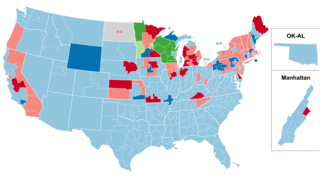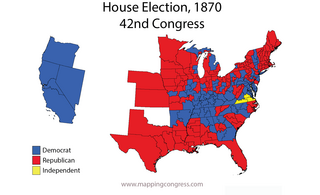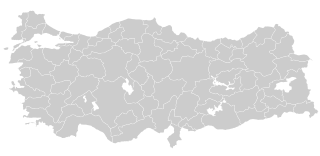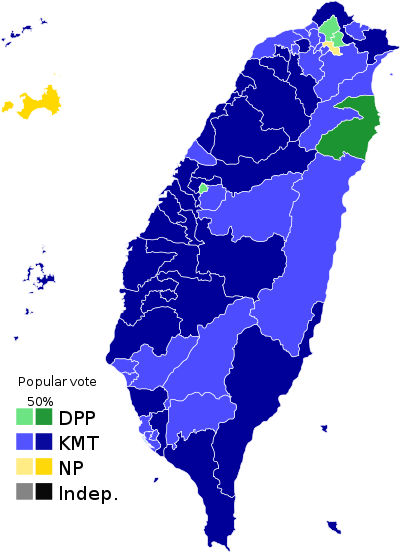2023 (MMXXIII) is the current year, and is a common year starting on Sunday of the Gregorian calendar, the 2023rd year of the Common Era (CE) and Anno Domini (AD) designations, the 23rd year of the 3rd millennium and the 21st century, and the 4th year of the 2020s decade.
A by-election, also known as a special election in the United States and the Philippines, a bye-election in Ireland, a bypoll in India, or a Zimni election in Pakistan, is an election used to fill an office that has become vacant between general elections.

The vice president of India is the deputy to the head of state of the Republic of India, i.e. the president of India. The office of vice president is the second-highest constitutional office after the president and ranks second in the order of precedence and first in the line of succession to the presidency. The vice president is also the ex officio chairman of the Rajya Sabha.

The 1920 United States Senate elections were elections for the United States Senate that coincided with the presidential election of Warren G. Harding. The 32 seats of Class 3 were contested in regular elections, and special elections were held to fill vacancies. Democrat Woodrow Wilson's unpopularity allowed Republicans to win races across the country, winning ten seats from the Democrats and providing them with an overwhelming 59-to-37 majority. The Republican landslide was so vast that Democrats lost over half of the seats that were contested this year and failed to win a single race outside the South.

The 1956 United States House of Representatives elections was an election for the United States House of Representatives to elect members to serve in the 85th United States Congress. They were held for the most part on November 6, 1956, while Maine held theirs on September 10. They coincided with the re-election of President Dwight D. Eisenhower.

The 1944 United States House of Representatives elections were elections for the United States House of Representatives to elect members to serve in the 79th United States Congress. They were held for the most part on November 7, 1944, while Maine held theirs on September 11. These elections coincided with President Franklin D. Roosevelt's re-election to a record fourth term.

The 1940 United States House of Representatives elections were elections for the United States House of Representatives to elect members to serve in the 77th United States Congress. They were held for the most part on November 5, 1940, while Maine held theirs on September 9. They coincided with President Franklin D. Roosevelt's re-election to an unprecedented third term. His Democratic Party narrowly gained seats from the opposition Republican Party, cementing their majority. However, the election gave firm control of the US House of Representatives and Senate to the New Dealers once again, as Progressives dominated the election.

The 1936 United States House of Representatives elections were elections for the United States House of Representatives to elect members to serve in the 75th United States Congress. They were held for the most part on November 3, 1936, while Maine held theirs on September 14. They coincided with President Franklin D. Roosevelt's landslide re-election. Roosevelt's Democratic Party gained twelve net seats from the Republican Party, bringing them above a three-fourths majority. This was the largest majority since Reconstruction, as the last time a party won so decisively was in 1866. This is the last time any party held 3/4ths of all House seats.

The 1934 United States House of Representatives elections were elections for the United States House of Representatives to elect members to serve in the 74th United States Congress. They were held for the most part on November 6, 1934, while Maine held theirs on September 10. They occurred in the middle of President Franklin D. Roosevelt's first term. The Democratic Party continued its progress, gaining another 9 net seats from the opposition Republican Party, who also lost seats to the Progressive Party. The Republicans were reduced below one-fourth of the chamber for the first time since the creation of the party. The Wisconsin Progressive Party, a liberal group which allied with the Democrats, also became a force in Wisconsin politics.

The 1926 United States House of Representatives elections were elections for the United States House of Representatives to elect members to serve in the 70th United States Congress. They were held for the most part on November 2, 1926, while Maine held theirs on September 13. They occurred in the middle of President Calvin Coolidge's second term. Coolidge's Republican Party lost seats to the opposition Democratic Party, but it retained a majority. The most pressing national matters at the time were fragmented, generally related to government's relationship to business or to providing social aid. However, no predominant issue was able to cast a shadow over the election. The small, populist Farmer–Labor Party also held two seats following the election.

The 1868–69 United States House of Representatives elections were held on various dates in various states between June 1, 1868 and August 2, 1869. Each state set its own date for its elections to the House of Representatives before or after the first session of the 41st United States Congress convened on March 4, 1869. They coincided with the 1868 United States presidential election, which was won by Ulysses S. Grant. Elections were held for all 243 seats, representing 37 states. All of the former Confederate states were represented in Congress for the first time since they seceded from the Union.
The 1850–51 United States House of Representatives elections were held on various dates in various states between August 5, 1850 and November 4, 1851. Each state set its own date for its elections to the House of Representatives before the first session of the 32nd United States Congress convened on December 1, 1851. Elections were held for all 233 seats, representing 31 states.
The 1848–49 United States House of Representatives elections were held on various dates in various states between August 1848 and November 1849. Each state set its own date for its elections to the House of Representatives before the first session of the 31st United States Congress convened on December 3, 1849. The new state of Wisconsin elected its first representatives, and California also held its first congressional elections before officially achieving statehood in 1850, increasing the size of the House to 233 seats.
The 1846–47 United States House of Representatives elections were held on various dates in various states between August 2, 1846 and November 2, 1847. Each state set its own date for its elections to the House of Representatives. 228 elected members representing 29 states took their seats when the first session of the 30th United States Congress convened December 6, 1847. The new states of Iowa and Texas elected their first representatives during this election cycle. These elections were held during President James K. Polk's term.
The 1844–45 United States House of Representatives elections were held on various dates in various states between July 1, 1844 and November 4, 1845. Each state set its own date for its elections to the House of Representatives. 224 elected members representing 27 states took their seats when the first session of the 29th United States Congress convened on December 1, 1845. The new state of Florida elected its first representative during this election cycle, while one vacancy in New Hampshire's delegation remained unfilled for the duration of the 29th Congress.

The 1870–71 United States House of Representatives elections were held on various dates in various states between June 6, 1870 and October 6, 1871. Each state set its own date for its elections to the House of Representatives before or after the first session of the 42nd United States Congress convened on March 4, 1871. They occurred in the middle of President Ulysses S. Grant's first term. Elections were held for all 243 seats, representing 37 states.

The 2024 United States elections are scheduled to be held, in large part, on Tuesday, November 5, 2024. During this presidential election year, the President of the United States and Vice President will be elected. In addition, all 435 seats in the United States House of Representatives and 34 of the 100 seats in the United States Senate will be contested to determine the membership of the 119th United States Congress. Thirteen state and territorial governorships and numerous other state and local elections will also be contested.

General elections are scheduled to take place on 14 May 2023. President Erdoğan had previously signalled that the election will be held early on 14 May 2023, a reference to the 1950 election that ended Turkey's one party regime. Presidential elections are held to elect the President of Turkey using a two-round system. Simultaneously, parliamentary elections are held to elect 600 Members of Parliament to the Grand National Assembly of Turkey.

The 2024 United States presidential election will be the 60th quadrennial presidential election, scheduled for Tuesday, November 5, 2024. It will be the first presidential election after electoral votes were redistributed during the 2020 census reapportionment cycle. The incumbent, President Joe Biden, stated in January 2022 his intent to run for reelection with Vice President Kamala Harris as his running mate. As of March 2023, Biden has not formally announced a reelection campaign. In November 2022, former president Donald Trump announced his candidacy for president for a second, nonconsecutive term. In the United States, general elections follow caucuses and primary elections held by the major parties to determine their nominees. The winner of the 2024 presidential election is scheduled to be inaugurated on January 20, 2025.

Mayoral elections in Irvine, California, are held every two years.













